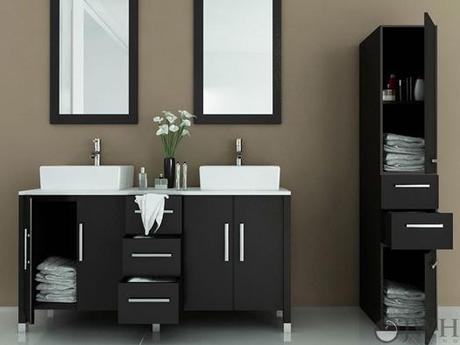One of the main issues that you’re going to encounter when shopping for bath (and kitchen) cabinets is the debate between framed and frameless cabinets. Framed cabinets dominated the market in the past but frameless cabinets have become much more desirable in recent years. Frameless cabinets are characteristic of European style cabinetry and are sometimes even referred to as European Cabinets.
The difference between a framed cabinet and a frameless cabinet is the face frame. A face frame is a frame that is affixed to the front of the cabinet. Imagine a cabinet without doors attached. The face frame is added to the front of the box cabinet to create a lip. This face frame adds strength and style to the front of the cabinet.

Frameless Bathroom Cabinets
What Your Decision Should be Based Upon: Opening Space, Rigidity of the Cabinet, Style
Your decision should be based on opening space, rigidity of the cabinet, and style.
Being that framed cabinets are more traditional woodworking techniques, you’ll find that old-school cabinet makers will recommend framed cabinets over frameless cabinets however, many in the industry realize that frameless cabinets are more than adequate.
Benefits of a Framed Cabinet
- Added strength to the cabinets construction
- Appealing to traditional senses
- Door glides are attached to the face frame
Benefits of a Frameless Cabinet
- More width at the opening of the cabinet
- Larger drawers
- Easier to replace door panels
- Thicker cabinet skeleton
- Appealing to modern and European senses
How They Compare on Durability
You’ll find varying opinions on this point. Some people will tell you that framed cabinets are more durable than frameless cabinets while others will say it doesn’t matter. The truth is that a quality frameless cabinet should be able to withstand whatever storage needs you may require of your bath/kitchen cabinets. Sure eliminating the face frame will save on materials but there are many other factors that determine the durability of a cabinet.
Some woodworkers and contractors will tell you that framed cabinets are better than frameless cabinets but this is not completely true. The strength of the cabinet depends on the materials and type of joint that is used on the skeletal construction of the cabinet. The two most common types of joints used are the butt joint and the mortise and tenon joint with the latter being superior. Dovetails joints are preferred on drawers as they hold together better unlike dowel joints which need to be re-tightened on a frequent basis.
Sometimes framed cabinets can actually be weaker because of the thickness of the wood use on to build the cabinets skeleton. When this happens, manufacturers decrease the thickness of the cabinets skeleton and add a face frame to be able to say that their framed cabinets are stronger. As you can see, the durability and quality of a cabinet relies on several factors.
Hinge Location
- Frameless - Door hinges are attached to the side of the interior of the cabinet box. The hinges will attach to the side of the cabinet lay flat.
- Framed – Door hinges are attached directly to the face frame with a clamp like shape that wrap around the front and back of the frame.
Size of the Opening
Framed Cabinets have smaller openings while the interior space of the cabinet is the same. The frame itself will decreases the size of the opening on the cabinet. This also means that frameless drawers will be larger than framed cabinet drawers.
With a standard face frame measuring 1 1/2″ on each side, you will lose 1/2″-1″ of space around the cabinet opening on a framed cabinet. For example, a 15″ wide cabinet face frame cabinet will have an opening space of 11 5/8″ as compared to a 13 1/8″ of a frameless cabinet. This is an estimate and can vary depending on the width of the face frame itself and the thickness of the cabinets skeleton.
Style & Design
Many chic and modern cabinets feature frameless construction to promote the simplicity of contemporary design. Framed cabinets tend to be more traditional as this was the most common technique historically.
Common Problems
Frameless cabinets made out of MDF or Particle Board are the most susceptible to issues of durability but this is true with any cabinet made out of MDF. Also, hinges attached to MDF will tend to loosen because they’re not secured to a solid wood material. Learn about the inherent benefits of solid wood cabinets over MDF by reading this post.
How they Compare on Price
Frameless cabinets are often times less expensive than framed cabinets but this is not always the case. Framed vs Frameless is not the final determinant on pricing. Pricing is dependent on a whole other list of factors including cabinet build material, hinges, paint-finish, drying technique, and countertop options among other things. Click below to begin browsing.
–View Framed & Frameless Cabinets–
Additional Resources:
- What’s the Best Material for a Bathroom Cabinet
- 10 Solid Wood Bathroom Vanities that Will Last a Lifetime
- Bathroom Vanity Buyers Guide
- The 5 Best Bathroom Vanity Brands
- 20 Small Bathroom Vanities that Are Big on Style
About the Author
Cheryl Khan is a designer and writer at Tradewinds Imports, an online specialty site dedicated to retailing fine bathroom furnishings. She has extensive knowledge about all the finer details that go into planning the perfect bath renovation project and is an expert in all things bathroom! Send her your bathroom Q’s on twitter @SuperInteriors!
